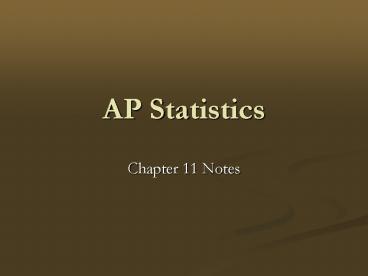AP Statistics - PowerPoint PPT Presentation
1 / 14
Title:
AP Statistics
Description:
AP Statistics Chapter 11 Notes Significance Test & Hypothesis Significance test: a formal procedure for comparing observed data with a hypothesis whose truth we want ... – PowerPoint PPT presentation
Number of Views:56
Avg rating:3.0/5.0
Title: AP Statistics
1
AP Statistics
- Chapter 11 Notes
2
Significance Test Hypothesis
- Significance test a formal procedure for
comparing observed data with a hypothesis whose
truth we want to assess. - Hypothesis a statement about a population
parameter.
3
Null (Ho) and Alternative (Ha) Hypotheses
- The null hypothesis is the statement being tested
in a significance test. - Usually a statement of no effect, no
difference, or no change from historical values. - The significance test is designed to assess the
strength of evidence against the null hypothesis. - The alternative hypothesis is the claim about the
population that we are trying to find evidence
for.
4
Example One-sided test
- Administrators suspect that the weight of the
high school male students is increasing. They
take an SRS of male seniors and weigh them. A
large study conducted years ago found that the
average male senior weighed 163 lbs. - What are the null and alternative hypotheses?
- Ho µ 163 lbs.
- Ha µ gt 163 lbs.
5
Example Two-sided test
- How well do students like block scheduling?
Students were given satisfaction surveys about
the traditional and block schedules and the block
score was subtracted from the traditional score. - What are the null and alternative hypotheses?
- Ho µ 0
- Ha µ ? 0
- You must pick the type of test you want to do
before you look at the data. - Be sure to define the parameter.
6
Conditions for Significance Tests
- SRS
- Normality (of the sampling distribution)
- For means
- 1. population is Normal or
- 2. Central Limit Theorem (n gt 30) or
- 3. sample data is free from outliers or strong
skew - For proportions
- np gt 10, n(1 - p) gt 10
- Independence (N gt 10n)
7
Test Statistic
- Compares the parameter stated in Ho with the
estimate obtained from the sample. - Estimates that are far from the parameter give
evidence against Ho. - For now well us the z-test.
8
P-Value
- Assuming that H0 is true, the probablility that
the observed outcome (or a more extreme outcome)
would occur is called the p-value of the test. - Small p-value strong evidence against H0.
- How small does the p-value need to be?
- We compare it with a significance level (a
level) chosen beforehand. - Most commonly a .05
9
P-value continued
- If the p-value is as small or smaller than a,
then the data are statistically significant at
level a. - Ex a .05
- If the p-value is lt .05, then there is less than
a 5 chance of obtaining this particular sample
estimate if H0 is true. - Therefore we reject the null hypothesis.
- If the p-value is gt .05, our result is not that
unlikely to occur. - Therefore we fail to reject the null hypothesis.
- If done by hand, the p-value must be doubled when
performing a 2-sided test. The calculator will
already display this doubled p-value if you
choose the 2-sided option.
10
Confidence vs. Significance
- Performing a level a 2-sided significance test is
the same as performing a 1 a confidence
interval and seeing if µ0 falls outside of the
interval. - e.g. If a 99 CI estimated a mean to be (4.27,
5.12), then a significance test testing the null
hypothesis H0 µ 4 would be significant at a
.01.
11
Reminders about Significance Tests
- 1. Dont place too much importance on
statistically significant. - Smaller p-value stronger evidence against H0
- 2.Statistical significance is not the same as
practical importance. - 3. Dont automatically use a testexamine the
data and check the conditions. - 4. Statistical inference is not valid for
badly-produced data.
12
Mistakes in significance testing
- Type I error
- Reject H0 when H0 is actually true.
- Type II Error
- Fail to reject H0 when H0 is actually false.
13
Errors Continued
14
Errors continued
- The significance level a is the probability of
making a Type I error. - Power The probability that a fixed level a
significance test will reject H0 when a
particular alternative value of the parameter is
true. - Ways to increase the power.
- Increase a
- Decrease s
- Increase n































